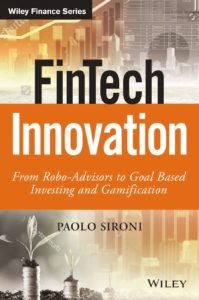A conversation with Paolo Sironi, FinTech
Thought Leader for IBM Watson Financial Services and spokesperson for investment and risk analytics.
How would you describe today’s digital transformation?
We live in a digital era which is revolutionising our lives at an accelerated pace. We are progressively dedicating more time to staying connected, as we are exposed to a global deluge of complex economic and financial information; which we are expected to interpret and be able to make clear, canny financial decisions. All the while, volatility reigns and stock markets continuously fluctuate between boom and bust. There is no doubt that many of us need better financial advice. The equation should be simple in a digital world:
one minus payments equals savings smart savings equals informed investing, borrowing, insuring
Yet, for decades, the banking relationship has been dominated by the asymmetry of information which has allowed professional players to bury our personal needs under a layer of complexities, fees and conflicts of interest. Nowadays, in the aftermath of the global financial crisis, the industry’s reputation is murky, and while regulators attempt to mend the system, financial firms have been hit by a perfect cocktail of FINancial TECHnology innovation.
How would you define FinTech?
FinTech is a global phenomenon, born at the intersection between financial firms and technology providers, it is the attempt to leverage on digital technology and advanced analytics to revolutionise financial services and harness economies of scale by targeting long-tail consumers and inefficient businesses with cheaper services.
They typically feature a high level of specialisation, hence very narrow and simple business propositions, to profit from a concerted effort to unbundle financial services into leaner digital offers. The FinTech environment changes very fast and is populated by new firms and ideas almost every quarter. By and large, they can be classified in digital lending, digital payments, big data analytics, blockchain architectures, Robo-Advisors, and residual models. Social media and digital technology are affording them the opportunity to leverage virtual networks among individuals, without the need for traditional intermediaries. Potential creditors can reach out “almost directly” to potential debtors, by pooling in small ticket investments to lending facilities specialised in personal lending or small corporate.
Mobile and wearable technology are granting IT firms unprecedented power to disintermediate centuries-old banking centrality of cash repository and payment services, and helps to foster financial inclusion in poor countries. As telecommunications and the world wide web have become fairly ubiquitous, we can nowadays visit smarter cities and pay-per-use on the underground using a smartphone instead of holding physical travel cards, carrying a credit card or unloading spare change out of our pockets. In this domain, blockchain technology has the potential to be truly revolutionary. The internet has favoured the global acceptance of social media and granted innovators with a fertile terrain to develop advanced analytics which identify, analyse, and target investors’ preferences, and track their digital interaction and peer-to-peer relationships. Big data analytics, behavioural analytics, and cognitive computing operate in this space. opportunity either to adopt these techniques as part of their operations or to create new business models that provide analytics-driven services, such as digital assessment of personal credit risk.

“The book spells out
a vision for the future
of personal banking in
which client’s needs take
centre stage.”
Is regulation a threat or an opportunity for innovation?
Regulation is indeed a cost but is the real engine of innovation, at least in wealth management, because it forces financial firms to change their business models and invest in new technology. One of the main consequences of the GFC has been a tightening of international regulations to increase the cost of capital and foster investor protection (MiFID2), affecting the economic relationship between product factories (asset managers) and final advisors (retail and private banks). This has ignited the rise of Robo-Advisors, which use digital tools to attract private money across a continuum of clientele, promoting low fees and tax harvesting, typically built on passive investments or portfolio algorithms that threaten asset and wealth managers. As a matter of fact, this has forced incumbents to launch Robo-Advisors solutions and play the new digital game of investment automation. Robo-Advisors are truly game changers of personal finance.
Can you tell us about your latest bestseller “FinTech Innovation”?
The main focus of “FinTech Innovation: from Robo-Advisors to Goal Based Investing and Gamification” is the digital transformation of personal banking by leveraging on personalised investment analytics, cognitive technology and compliant business models. The book spells out a vision for the future of personal banking in which clients’ needs take centre stage, gamification helps them learn how to make better investment decisions, and the industry thrives in a more symmetrical, transparent and riskcontrolled landscape.
Can technology make our lives easier and decision-making more intuitive? Would technology help human advisors or de-humanise our social and professional well-being? Do we fully trust our advisors? How does a Robo-Advisor work?
FinTech Innovation answers these questions and more. What investors want is to access cost-effective, added-value services: simpler, more personalised and 100% trustworthy. What banks want is to regain the customer’s confidence, increase revenues, reduce costs and comply with regulations. What regulators demand is transparency and fairness. What FinTech companies look for is growth by exploiting technology and user experiences to close the gap between investors’ needs and traditional services.



























